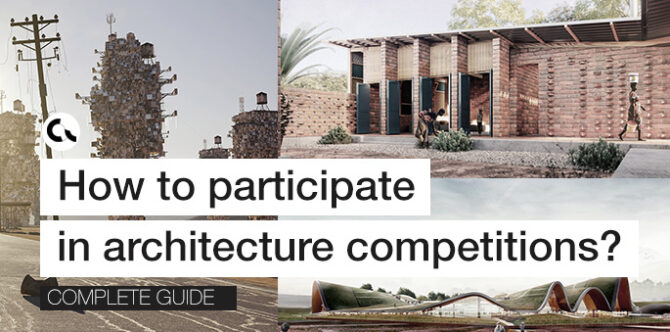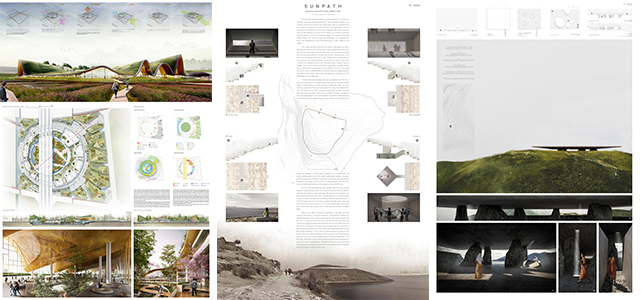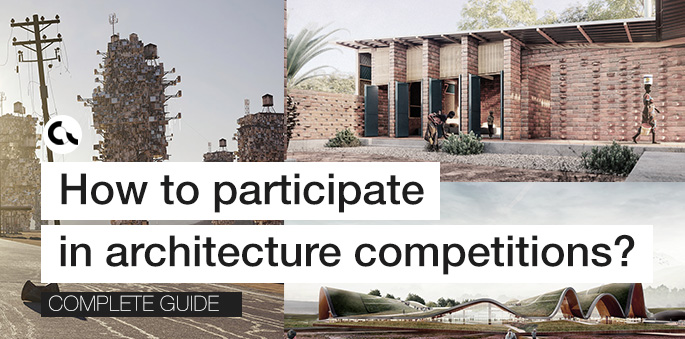Participating in architecture competitions is a meaningful part of university studies and architecture professional career. There are many benefits that come from facing this type of challenges. Starting from getting knowledge and gaining experience, through learning time management or collaboration skills, finishing on possibility to be awarded as well as getting appreciation in the architecture world. But, no pain, no gain. Participating in architecture competition is a long and very demanding process that requires devoted commitment. In this article we would like to explain how “competitions world” works, how to choose the most suitable challenge and start your first entry as well.
Moreover, we would like to help you organize your work and give tips that will make your presentation boards stand out. Following steps below you will be able to improve every submission and increase your chances of winning the competition. So, let’s get started!

01 Choose the most suitable architecture competition
Types of competitions
What you need to know at the beginning is that there are many types of competitions that could be called architecture ones. The first group includes architecture concept competitions. Those are challenges demanding from the participants thinking outside the box and seeking for the most innovative solutions. The idea is the crucial thing, and its graphical expressions should be readable from the first sight. Secondly, competitions with building-award. While taking part in this type, it is important to explain, apart from the main idea, how the structure works, what materials were used for construction and finishing, how the design influences the surrounding. Furthermore, there are rendering challenges where contestant should focus on the frame, colors, composition, and atmosphere that supposed to tell the story about the design. There are also architecture writing competitions. This type enables participants to share their thoughts about phenomenon in contemporary architecture, express new ideas and thesis, and ways they thinking architecture.
There is enormous amount of architecture competition available on the market. The first step is to realize what is the most interesting aspect of architecture for you in this moment. Would you like to make entry that will be focused on sustainability, maybe you would prefer proposing a solution for sociological issues or help in renovation by bringing second life to the ruined buildings? What types of building you simply like designing? Do you feel better during working on housing areas or places for exhibitions?
Competition organizers
After answering those questions, you can visit all competition section on Competitions.Archi website, where you can find all recently released competitions with short descriptions and direct links to the competitions’ homepages. You can also check the following competitions organizers.
- BEE BREEDERS
- Non Architecture
- Archstorming
- Kaira Looro Architecture Competition
- ARKxSITE
- Quechua Architecture Competition
- YOUNG ARCHITECTS COMPETITIONS

02 Individually or in a team?
The next decision that needs to be made is choosing people to collaborate with. When you work with others you can exchange your thoughts easily. Once said idea, might be developed by another team member or rejected. Cooperation with colleagues limits the possibility of getting stuck. Finally, it enables sharing the work. As a result, you will not have to do everything on your own. One people are better in rendering, the others in drawing or making sketches. You can divide tasks in a way that everybody will do things he/she is the best of. Taking advantages of individual skills, your work will be very efficient and the final outcome – the most effective. On the other hand, setting meeting together might be found sometimes very difficult. Working with other requires making compromises as well. For those who feel underestimated by the teammates or would like to try their own chances, we recommend participating in the architecture competition individually.
03 Time management
A proper time management is a key to a successful submission. You might find establishing some collaboration rules at the beginning very helpful. It’s good to know how many hour during the week you can spend on designing process and organize some regular meetings to monitor the effects weekly. Some of you could plan stages of the process, for example by giving the deadlines to particular tasks and establishing the goals for each week. You make sure that every member of the group know exactly what should be done before next meeting. And finally, no matter how regularly you work, you will need extra time for “the last” changes and improvements. Our advice is to take at least one day off before the submission closing to focus only on the competition. As a result, you will submit the best possible entry.
04 Searching for ideas
The main idea is the essential aspect of the project. Looking through many winning submissions, we could see that they have one thing in common – a strong leading idea visible on every drawing or visualization, which makes the whole project consistent. But, how to know which idea is “the one”? How to find the right one?

If you do not have anything that comes to your mind at the beginning, start looking for inspirations. It can be anything – wining submission from the previous edition, movie you have already seen, book you have read. For example, winners of eVolo 2020 found their winning idea during playing a video game called Hideo Kojima’s Death Stranding and the short visualization of communication tower inspired them.

You can look for inspiration on Pinterest or Instagram, visiting Competitions.Archi Profiles. You will get there enormous amount of architecture presentation boards with short descriptions that may open your mind. You can also very carefully search for winnings submissions from the previous editions of the competition and try to understand what made them win.
You can go further and do research about the context and cultural background of the designing area. Reading the Chinese myth of Pangu was the first step for Mograph studio to win Xi’an Train Station Competition organized by Young Architects Competition. It stared their process of form finding which brought them awards and recognition.

It might be also helpful to sit with your teammates around one table and make brain-storming. The most important rule is to stay open to every idea and give it chance to grow. Try to write down all associations you have with the topic and maybe one of them will be a key to your success. Maybe, it will become a main theme or title determining the whole designing process.
05 Making presentation boards stand-out
Everything we draw as architects needs to be functional as well as simply beautiful. Graphical expression is a very important part of final submission. There are plenty of well-designed and organized projects but your panels need to be outstanding to be chosen as the winning ones. The submission needs to be extraordinary to be noticed by the jury and very often the brilliant idea is not enough. Below you can find some tips how to enrich your presentation boards.

Prepare presentation boards layout
It is important to make the board clear and readable. When jury has to analyze your project too long, there is little chance for success. If you submit more than one presentation board, make sure that all panels are consistent and look like one whole. You can check also previous years editions to see what types of layout are preferable by the competition’s organizers. What you need to remember is that the whole board needs to look like a designed and think-through composition, where blocks with drawings and visualizations suit each other. Make selection of drawings. When you work a lot on the design, it is natural that you want to show as many aspects of the project as you can. Unfortunately, it leads to the effect that the project board starts looking overfilled and unclear. The solution is to choose drawings you are the most satisfied with and include them as the main ones.
 Competitions.Archi prepared Project Board Template Pack that includes 20 awarded presentation panels in competitions launched in last years. Clicking on the banner o the left you can download 20 different architecture representation templates in InDesign and Photoshop formats absolutely for FREE. There are 10 landscape and 10 portrait layouts that you can modify and adjust to your design.
Competitions.Archi prepared Project Board Template Pack that includes 20 awarded presentation panels in competitions launched in last years. Clicking on the banner o the left you can download 20 different architecture representation templates in InDesign and Photoshop formats absolutely for FREE. There are 10 landscape and 10 portrait layouts that you can modify and adjust to your design.
Making main idea visible
The good idea is to create color palette at first and stick to this during creating graphics. You will also need to find the way to show the best what is the project about. Very often you can use a contrast color to underline the most important aspects of the design. Entitle your project in a way that will make the readers curious and give them a hint what it might be the concept behind. You can also prepare a big-size visualization showing the atmosphere the architecture might be creating. Drawing diagrams might help to understand your design as well. Creating functional diagrams enables jury to figure out how the building would work. You can explain using step-by-step diagrams what were the stages of form finding process. Sometimes it is very important to show the correlation with the existing buildings and urban diagrams are adequate type of drawings to do so.



Visualizations and framing
Not only the presentation board layout should create the composition itself but also frames of the visualization or pictures supposed to be carefully adapted. Creating architecture visualization you should thing what kind of emotion you want to transmit to the spectators. The picture needs to illustrate the atmosphere inside the building, make character of the architectural piece as well as encourage jury to explore the design more. The composition is the frame of the image and how the elements of the scene appear in it, is a guideline that must be observed when telling stories visually.
The Fairy Tales Competition Winners shown us the way they compose their visualizations. They use symmetrical, asymmetrical composition to achieve different goals. Their methods of composing are describe in details in article called ‘How we won that competition? | Fairy Tales 2020 – The Year Without a Winter’.

Importance of 3d views
Recently we can see the tendency that standard 2d drawings are replaced by axonometric views or perspectives. Drawing axonometry is a perfect way to show special relations and the scale of the building. Perspectives and rendering enable us to express the atmosphere, the materials used and can make different impressions to the viewers.
Submission
To make your work eligible you need to meet all competition requirements. So make sure that there is no identification sign except of registration number. Before submitting, check the spelling of every headline and make sure that there is everywhere graphical scale, which helps in understanding the size and volume of the design better than the numerical scale. Be certain if every drawing is updated and in final version. Make sure that nothing is moved accidentally and everything is in established order.
06 What to do when you become a winner?
Firstly, Celebrate! Secondly, tell the world you made it, share it on your social media and let Competititons.Archi know about it.
If you are interested how to win an architecture competition and learn real stories written by the authors about their awarded submissions, check our annual publication – Architecture Competitions Yearbook. This book is perfect for you if you want to know:
- What’s the secret behind winning submissions?
- What makes a good project?
- How to create an innovative solution to the given problem?
…and much more.
Learn more by clicking the banner below.









